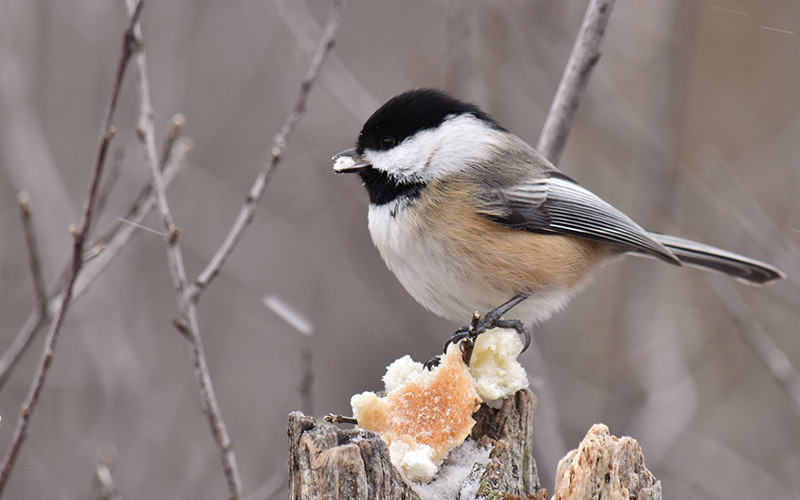
by guest blogger Toni Becker, member of the Rodale’s editorial team
Welcome to the long days of winter! As you hunker down in your home and wonder if spring will ever arrive, take a moment to think about your feathered friends.
While many people think birds can fend for themselves when the weather gets dicey, the truth is, they need our help. Finding shelter, foraging for food and water, and fending off predators can be daunting tasks in frigid, snowy weather—especially when you’re focused on just getting warm.
Every region has its own special birds, but there is a core group that shows up nationwide during winter. Those are chickadees, doves, goldfinches, house finch, jays, juncos, nuthatches, native sparrows, titmice, and woodpeckers. How can we ensure they are well cared for when temperatures drop and conditions get bad? We can start by providing the basics.
1. Food
Most winter birds are seedeaters, so make sure to keep a variety of seeds on hand, particularly those that are high in fat. Black oil sunflower seed is universally pleasing, takes little effort to eat, and is a great energy booster. Peanuts are also good. With insects scarce or absent, suet is an excellent high-calorie food that can prove invaluable to birds’ survival. You can also create your own homemade mixes using peanut butter, mealworms, canola oil, or cornmeal! Dried or fresh fruit is also a welcome addition for lingering fruit eaters. Try offering it with this Wire Twig Hanging Fruit Spear!
Tips:
- Food can be placed in feeders, spread or hung on trees, scattered over bushes, or tossed on the ground. To feed specific species, you’ll want to look into their feeding preferences.
- Make sure to clear off feeders as soon as possible following a storm.
- Stock up on suet, homemade mixes, or homemade bird food and stash it in your fridge or freezer. Break the food into chunks before freezing, so you can easily grab what you need.
- Dog and cat food are cheap, quick alternatives if you run out of other bird food.
2. Water
Water is scarce in winter, and birds expend a lot of energy trying to convert it from snow. Help them out by adding hanging or freestanding birdbaths around your yard and keeping them supplied with fresh water. To keep the water from freezing, use a heated birdbath or one that continuously circulates the water.
Tip:
- If you don’t have a heated birdbath, fill shallow pans with water and distribute these throughout the yard. Refill them regularly.
3. Shelter
In winter, birds seek out enclosed spaces that will help them retain body heat. Cozy birdhouses like this Coconut Fiber one are great for wrens and other small birds, as is this Birdhouse Kit. Fallen branches, dead gardens, and piles of shrubs can be a winter paradise for birds. Add a log or keep a few unattended piles of dead branches in your yard to give birds a place to burrow when times get tough. You can also keep your garden intact after your last harvest. Depending on what you leave, birds can munch on the remaining seeds.
Tips:
- Hang birdhouses out of the way of wind and near covering to protect occupants from snow, ice, and rain.
- Still have your Christmas tree? Set it up outside and hang some bird treats like this birdseed feeder set or giant pinecones.
- Consider planting native trees that will provide birds great shelter. Conifers and broad-leaved evergreens are great for blocking rain, snow, and ice. Talk to a local nursery to select the best bird-loving trees for your area.
4. Protection from Dangers
Cats pose a real threat to birds, and are especially troublesome in wintertime, when birds need to reserve their energy and not waste it trying to get away. If you have cats, keep them indoors. If stray cats frequent your yard, get diligent about shooing them away. Loud noises, a bit of chasing, or annoying garden sprinklers will deter them from venturing into your backyard. Another danger to birds is large glass windows. Birds regularly fly into them, sometimes while trying to evade predators. Put a barrier between birds and windows, use window screens, or hang reflective ultraviolet stickers.
Tip:
- Situate birdhouses and feeders near a covering but within plain view of the surroundings, helping birds sight predators.
Keeping these basic needs in mind will equip backyard birds with the tools for survival, and ensure that we all enjoy a joyous spring!
 Toni Becker is a part-time content creator at Rodale’s. She is also the personal chef, event planner, chauffeur, and best of all playmate to her young daughter. Her family of three lives in the woods where she finds time to write, cook anything she can from scratch, garden, and build her case of why she needs goats.
Toni Becker is a part-time content creator at Rodale’s. She is also the personal chef, event planner, chauffeur, and best of all playmate to her young daughter. Her family of three lives in the woods where she finds time to write, cook anything she can from scratch, garden, and build her case of why she needs goats.
Adapted from Backyard Bird Secrets and The Backyard Bird Lover’s Ultimate How-To Guide, both by Sally Roth.




No comments yet.